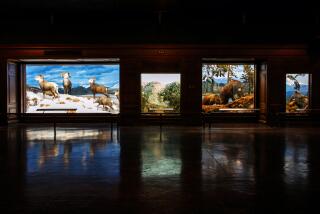Evolution of Charles Darwin Is Traced in Museum’s Pictorial Exhibit
- Share via
The house in Down, England, is vine-covered and surrounded by trees. The dominant color of the place, depicted in a lithograph of a 19th-Century watercolor, is green.
The house is where naturalist Charles Darwin lived with his wife and 10 children, where he wrote and refined his ideas about everything from the evolution of man to the life and diet of earthworms.
“He was so eloquent and had so much to say about man in general and the place of man and nature in science,” said anthropologist Diane Perlov, associate curator of the California Museum of Science and Industry in Los Angeles.
“A lot of what is considered ‘Darwinism’ is still controversial and a lot of people still know very little about him,” she said.
The museum is sponsoring a pictorial exhibit of Darwin’s life from age 7 to 73 in a series of 39 photographs assembled by Ohio biologist Gene Kritsky, who professes an interest in the work and theories of the bearded theoretician for more than a quarter of a century.
The rare pictures, accompanied by Darwin memorabilia and biographical quotations from the naturalist’s writings, reveal an unusual portrait of Darwin not only as scientist, but also as father and husband.
“I do not believe that she ever missed an opportunity of doing a kind action to anyone near her,” Darwin wrote of his wife, Emma. “I marvel at my good fortune that she, so infinitely superior in every single moral quality, consented to be my wife.”
The litho of the house in Down pictures Darwin and Emma seated together on the veranda of the house he chose because of its variety of vegetation. By the time he died in 1882 at the age of 73, he had written voluminously on plant life and had circumvented the globe in his famous voyage aboard the Beagle.
Darwin also was the subject of numerous editorial cartoons, one of the most famous picturing a likeness of his head connected to the body of a chimp.
Pundits and artists drew much of the subject matter for their attacks against the scientist from interpretations of Darwin’s “The Origin of Species,” the book that set Victorian England astir when it was published in 1859. The book’s theoretical centerpiece is the idea of natural selection.
Essentially, the theory suggests that the origin and diversification of species results from a gradual accumulation of individual modifications.
Heady stuff in the midst of literal interpretations of biblical literature, especially in light of his idea that organisms better adapted to their environment--those with favorable variations--survive and reproduce.
Darwin also admitted in that straight-laced era a fascination with sexual reproduction.
“The theory of evolution and the idea of man in that scheme was especially important to anthropological theory by the turn of the century,” Perlov noted. “What he wrote was not just restricted to biology; he affected the thinking of anthropologists and social scientists as well.”
Darwin, reflecting on the path that led to his writing “Origin of Species” and “The Descent of Man,” published in 1871, was once quoted as saying that his interest in natural history dated to his childhood.
“By the time I went to day school,” he wrote, “my taste for natural history and more especially for collecting was well developed. I tried to make out the names of plants and collected all sorts of things--shells, seals, coins and minerals.”
Kritsky, who chairs the biology department at the College of Mount St. Joseph in Cincinnati, said he is convinced that “people are more than what they do.”
“If people understand Darwin the man, perhaps they can better understand Darwin’s theories.
“His is still the major view as far as evolutionary biology is concerned,” Kritsky observed. “He accomplished two things when he did his work. First, he established that evolution took place, and second, he provided a mechanism for evolution.
“Today we widely accept evolution as the cornerstone of biology and that natural selection is still the primary force behind it.”
Kritsky, who traveled throughout England to find the daguerreotypes and watercolors of the scientist whose work fell into what today would be the fields of biology and geology, said Darwin’s ideas may never escape the wrath of the religiously devout.
“When I was in the eighth grade I was in a religious school and was told by my teachers that evolution was wrong,” he said. “They told me that he (Darwin) was an evil man and a tool of the devil. So that night I went to a department store and bought a book on evolution for 95 cents and was flabbergasted.
“He changed my way of thinking. But Darwin’s ideas do not invalidate religion. The Bible tells you how to get to heaven, not how heaven was made.”
More to Read
The biggest entertainment stories
Get our big stories about Hollywood, film, television, music, arts, culture and more right in your inbox as soon as they publish.
You may occasionally receive promotional content from the Los Angeles Times.










